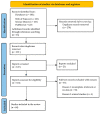Polyorchidism: An Up-to-Date Systematic Review
- PMID: 36675578
- PMCID: PMC9863743
- DOI: 10.3390/jcm12020649
Polyorchidism: An Up-to-Date Systematic Review
Abstract
Polyorchidism is a rare male urogenital tract anomaly characterized by at least one supernumerary testis in the scrotum or ectopically. According to data based on our systematic review, 76% of the supernumerary testes (SNTs) were located in the scrotum, and 24% were extra-scrotal (p < 0.001). Among testes located outside the scrotum, 87% were found in the inguinal canal and 13% in the abdominal cavity. In 80% of cases, the diagnosis of SNT was made based on imaging tests, and the remaining 20% of cases were detected incidentally during surgery. The imaging tests performed (US or MRI) resulted in a significantly higher rate of patients who qualified for observation vs. surgical treatment (45% vs. 35%, p < 0.001). The most common conditions associated with SNT were ipsilateral inguinal hernia (15% of cases) and cryptorchidism (15% of cases). Surgery (orchidopexy/orchidectomy) was performed on 54% of patients with SNT, and the decision to observe the SNT was made in a total of 46% of patients (p = 0.001). The therapeutic approach depends on the location of the SNT and the presence of factors that raise suspicion of neoplastic proliferation.
Keywords: anatomical anomalies; gonads; polyorchidism; supernumerary testis; urogenital system; urology.
Conflict of interest statement
The authors declare no conflict of interest.
Figures



References
Publication types
LinkOut - more resources
Full Text Sources

